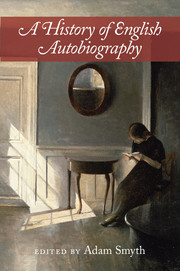Book contents
- Frontmatter
- Dedication
- Contents
- List of contributors
- 1 Introduction: The range, limits, and potentials of the form
- PART 1 AUTOBIOGRAPHY BEFORE ‘AUTOBIOGRAPHY’ (CA. 1300–1700)
- PART 2 RELIGION, GENDER, THINGS (CA. 1700–1800)
- PART 3 THE MANY NINETEENTH CENTURIES (CA. 1800–1900)
- PART 4 RELATIONAL LIVES AND FORMS OF REMEMBERING (CA. 1890–1930)
- PART 5 KINDS OF COMMUNITY (CA. 1930-CONTEMPORARY)
- Index
- References
1 - Introduction: The range, limits, and potentials of the form
Published online by Cambridge University Press: 05 March 2016
- Frontmatter
- Dedication
- Contents
- List of contributors
- 1 Introduction: The range, limits, and potentials of the form
- PART 1 AUTOBIOGRAPHY BEFORE ‘AUTOBIOGRAPHY’ (CA. 1300–1700)
- PART 2 RELIGION, GENDER, THINGS (CA. 1700–1800)
- PART 3 THE MANY NINETEENTH CENTURIES (CA. 1800–1900)
- PART 4 RELATIONAL LIVES AND FORMS OF REMEMBERING (CA. 1890–1930)
- PART 5 KINDS OF COMMUNITY (CA. 1930-CONTEMPORARY)
- Index
- References
Summary
I am a camera with its shutter open, quite passive, recording, not thinking. Recording the man shaving at the window opposite and the woman in the kimono washing her hair. Some day, all this will have to be developed, carefully printed, fixed.
Christopher Isherwood[T]he whole matter is reduced to the papers.
Algernon SidneyThe twenty-nine chapters and 170,000 words that comprise A History of English Autobiography take as their subject autobiographical writing in England from the medieval period to the digital contemporary. The chapters represent the critical state of play in the field, and intervene in urgent ways with current thinking, often through the deployment of new research. Thus, running through several chapters is an engagement with the latest scholarly issues of debate, including, for example, the medical humanities; the materiality of texts; the history of reading; and objects and thing theory. The narrative is an English one, but it frequently engages with non-English authors (including Augustine, Rousseau, and Freud) who were important for the development of English autobiographical writing.
The book is structured chronologically, and has a spine of canonical texts: in this sense, English Autobiography will serve as the ideal source for a reader coming to the topic for the first time, or seeking to set their period-specific knowledge in a broader context. But alongside this robust coverage, the collection also treats ‘autobiography’ in ways that are expansive, imaginative, and suggestive. The collection does this in part by greatly expanding the chronological range normally given over to histories of autobiography: backwards, into the medieval and early modern, and forwards, into the contemporary world of social media, smartphones, and omnipresent digital cameras.
One of English Autobiography's central contentions is that autobiography, in its widest sense, is not an exclusively modern, post-Romantic phenomenon, but a way of writing and reading that has a much richer, longer history. Standard histories of the form often discuss Augustine's Confessions and perhaps one early modern writer (usually either Montaigne or Bunyan), before finding a real beginning with Rousseau's Confessions (1782). The pre-1750 serves as a space for throat-clearing or limbering up – but this is to miss a wealth of significant texts, authors, and lives. In Part 1, ‘Autobiography before “autobiography” (ca. 1300–1700)’, coverage of medieval and early modern forms of autobiographical writing provides a crucial pre- or counter-history to the better-known story of autobiography's nineteenth-century origins.
- Type
- Chapter
- Information
- A History of English Autobiography , pp. 1 - 10Publisher: Cambridge University PressPrint publication year: 2016
References
- 9
- Cited by



